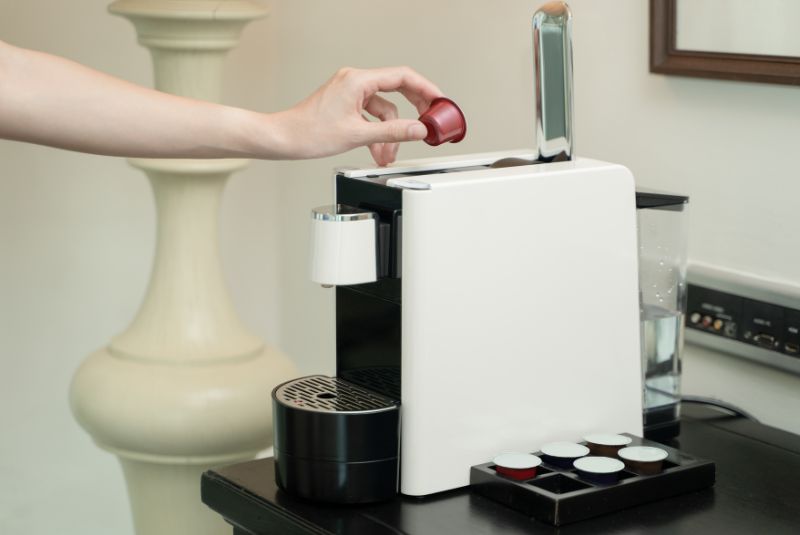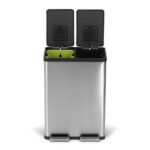Do you want to keep your coffee maker in top shape and enjoy the best tasting coffee possible? Learn how to descale your coffee maker with this easy step-by-step guide!
[content-egg-block modules=AmazonNoApi template=offers_grid cols=3 groups=”SectionIntro” hide=rating]
Gather Supplies
- Collect white vinegar, water, a clean cloth, and a timer.
- Grab a bottle of white vinegar from your pantry and fill a small bowl with it. Make sure to choose white vinegar, as it works best for cleaning purposes.
- Fill another bowl with water. You will use this to dilute the vinegar and create a gentle cleaning solution.
- Get a clean cloth or paper towel. This will be used to apply the vinegar solution and wipe down surfaces.
- Don’t forget to grab a timer. You can use your phone, a kitchen timer, or any other device to keep track of the cleaning time.
- Having these supplies ready will make the cleaning process smoother and more efficient.
[content-egg-block modules=AmazonNoApi template=offers_grid cols=3 groups=”Step1″ hide=rating]
Prepare the Solution
Mix equal parts of water and white vinegar in the coffee maker’s water reservoir. For example, if your coffee maker’s water reservoir holds 8 cups of liquid, pour in 4 cups of water and 4 cups of white vinegar. This step helps to clean out any mineral build-up or residue in the coffee maker. Once you have added the mixture, run a brew cycle without any coffee grounds. This will allow the water and vinegar solution to clean the internal components of the coffee maker thoroughly. After the cycle is complete, rinse the water reservoir thoroughly with clean water to ensure all traces of vinegar are removed.
Run a Brewing Cycle
Start the brewing cycle without adding coffee grounds. Allow half of the solution to brew, then pause the cycle and let it sit for about 30 minutes. This step helps to clean the coffee maker and remove any residual oils or build-up from previous brews. After the 30 minutes are up, resume the brewing cycle to complete the cleaning process. Remember to discard the solution once the cycle is done to ensure the next brew is fresh and free from any cleaning residue.
Complete the Cycle
To resume and finish the brewing cycle, start by discarding the vinegar-water solution from your coffee maker. Ensure the coffee maker is turned off and cooled down before proceeding. Carefully remove the carafe and dispose of the mixture. Next, rinse the carafe thoroughly with fresh water to remove any vinegar residue. Then, place the carafe back onto the coffee maker. Afterward, fill the water reservoir with clean, fresh water up to the maximum level indicated. Now you can proceed to run a brewing cycle with just water. This will help to flush out any remaining vinegar taste and residue from the machine. Once the cycle is complete, your coffee maker will be ready for regular use with a fresh, clean start.
Rinse the Coffee Maker
- After descaling your coffee maker with vinegar, run a cycle with plain water. This step will help to remove any remaining vinegar taste or residue from the machine.
- Fill the water reservoir with fresh, clean water.
- Start a brewing cycle without adding any coffee grounds.
- Allow the cycle to complete fully.
- Discard the water from this cycle.
- Repeat the process if there is still a lingering vinegar taste or smell.
Remember, this step is crucial to ensure that your coffee maker is free from any vinegar remnants and ready for your next delicious cup of coffee!
Clean External Parts
Wipe down the exterior of the coffee maker with a damp cloth to remove any residue. Start by unplugging the coffee maker for safety. Dampen a clean cloth with warm, soapy water – avoid using abrasive cleaners. Gently wipe the entire exterior surface of the coffee maker, paying special attention to areas where coffee or water may have splashed. Ensure you wring out excess water from the cloth to prevent any drips onto the machine. Once you’ve wiped down the exterior thoroughly, use a dry cloth to wipe off any remaining moisture. Once the coffee maker is completely dry, you can plug it back in and enjoy your next brew without any residual grime.
Maintenance and Final Tips
Here is a concise Conclusion for a blog post titled “How to descale a coffee maker?”:
“By following these steps, you can easily descale your coffee maker and keep it in top condition. This simple maintenance routine will not only prolong the life of your machine but also guarantee a delicious cup of coffee every time you brew. Cheers to a freshly descaled coffee maker and consistently great coffee!
Necessary Supplies
[content-egg-block modules=AmazonNoApi template=offers_list groups=”Materials”]
Maintenance Made Easy
Operating the Coffee Maker
- Fill the water reservoir with the desired amount of water
- Place a coffee filter in the filter basket and add your ground coffee
- Close the filter basket and ensure the coffee pot is in place
- Turn on the coffee maker and select your desired brewing option (e.g., regular or bold)
- Once the brewing is complete, pour yourself a delicious cup of coffee and enjoy!
Common Questions About Coffee Makers
Yes, a coffee maker with a reusable filter can indeed save you money in the long run. While the initial cost of a reusable filter may be higher than a pack of disposable filters, you will save money over time by not having to regularly purchase new disposable filters. Reusable filters are more cost-effective in the long term and also reduce waste, making them a more environmentally friendly option. So, investing in a coffee maker with a reusable filter can be a smart choice for your wallet and the environment.
Sure! The main difference between a pour-over coffee maker and a traditional coffee maker is the brewing process.
In a traditional coffee maker, water is heated and dripped over coffee grounds in a filter, usually in an automatic machine. This method is more hands-off and convenient for making multiple cups of coffee at once.
On the other hand, a pour-over coffee maker involves manually pouring hot water over coffee grounds in a filter. This method allows for more control over the brewing process, resulting in a more customizable and potentially richer flavor profile.
So, in summary, the main difference lies in the manual control and precision of the brewing process in a pour-over coffee maker compared to the more automated process of a traditional coffee maker.
Yes, there are coffee makers that can brew both hot and iced coffee. Some models come with a specific setting for brewing iced coffee, while others allow you to adjust the settings to brew either hot or cold coffee. Look for coffee makers with features like adjustable brewing temperature and strength settings to ensure you can easily switch between brewing hot and iced coffee.
Yes, a coffee maker with a thermal carafe can keep coffee hot for longer compared to a traditional glass carafe. Thermal carafes are designed to retain heat better, which helps to keep your coffee hot for several hours without needing a heating element. This can be a great feature if you like to enjoy your coffee over an extended period of time without it getting cold.
A typical coffee maker usually takes around 5 to 10 minutes to brew a full pot of coffee, which is typically about 10 to 12 cups. Keep in mind that this can vary depending on the specific model of the coffee maker and the brewing method it uses.
A stovetop espresso maker, also known as a Moka pot, brews espresso using steam pressure generated by boiling water in the lower chamber. On the other hand, an electric espresso machine uses a pump to force water through the coffee grounds at higher pressure, typically producing a richer crema and a more consistent extraction. In summary, the main difference lies in the brewing process – stovetop uses steam pressure, while electric machines use pump pressure.
A drip coffee maker works by heating water in a reservoir and then pouring it over coffee grounds in a filter. The hot water extracts flavors from the coffee grounds as it drips through them and then collects in a carafe below. This method allows for a simple and efficient way to brew coffee at home or in a commercial setting.
Yes, there are coffee makers that offer customizable brewing options for different coffee strengths. These coffee makers typically have settings that allow you to adjust the brewing time, water temperature, and coffee-to-water ratio to achieve your desired coffee strength. Some popular models include the Ninja Specialty Coffee Maker, Breville Precision Brewer, and the OXO Brew 9-Cup Coffee Maker. These machines give you the flexibility to experiment with different brewing parameters to customize your coffee to your preferences.
To use a French press coffee maker, start by boiling water. Coarsely grind coffee beans and add them to the French press. Pour hot water over the grounds, stir, and place the lid on top with the plunger pulled all the way up. Let it steep for about 4 minutes. Slowly push the plunger down to filter the grounds. Pour the freshly brewed coffee into a mug and enjoy!
To clean and maintain a pod coffee maker, you should follow these steps:
- Regularly descale your machine: Depending on the hardness of your water, you may need to descale your coffee maker every 2-3 months to prevent mineral buildup.
- Clean the external surfaces: Wipe the outside of the machine with a damp cloth and mild detergent to keep it looking new.
- Remove and clean the drip tray and water reservoir: These parts can collect coffee residue and bacteria, so they should be removed and cleaned with warm, soapy water regularly.
- Run a cleaning cycle: Some pod coffee makers have a cleaning cycle that you should run periodically to keep the internal components clean.
- Replace the water filter: If your machine has a water filter, make sure to replace it according to the manufacturer’s instructions to ensure the best-tasting coffee.
By following these steps, you can keep your pod coffee maker clean and well-maintained for delicious coffee every time!






